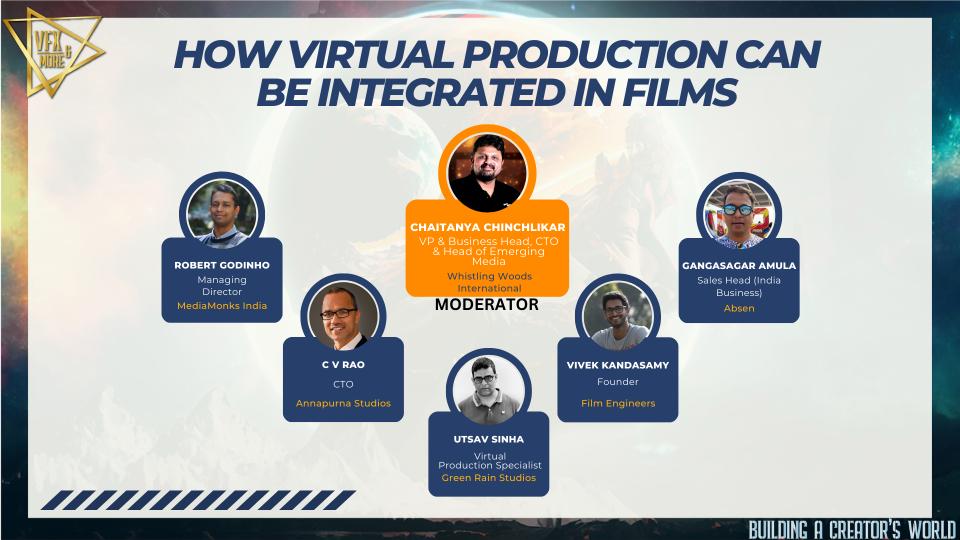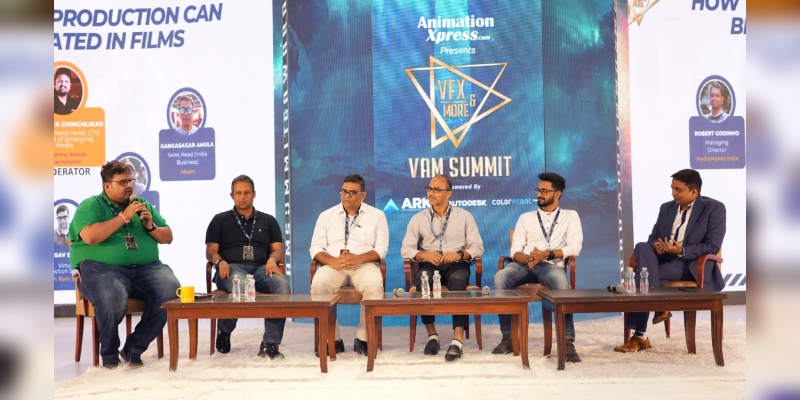
The VAM Summit & Awards conducted by AnimationXpress was held on-ground in Mumbai on 23 March at The Lalit and 24 March at Cinepolis, Fun Republic. This edition – which had 700 plus attendees – witnessed panel discussions, sessions, masterclasses and awards.
One session on the first day of the summit was on How Virtual Production (VP) Can Be Integrated in Films. This session’s moderator Whistling Woods International vice president & business head, CTO & head of emerging media Chaitanya Chinchlikar gave a small presentation explaining the nuances of VP. For the discussion, MediaMonks India managing director Robert Godinho, Green Rain Studios virtual production specialist Utsav Sinha, Annapurna Studios CTO C V Rao, Film Engineers founder Vivek Kandasamy and Absen sales head (India business) Gangasagar Amula joined as speakers.
Where does India’s VP industry stand and where is it likely to go in the next five years? How much budget and planning is required to shoot on VP? Chinchlikar started the discussion by emphasising if filmmakers are asking the right questions when it comes to shooting on VP. “There isn’t enough awareness,” MediaMonks’ Robert Godinho replied. For people to start asking the right questions, “We need to do more open-houses, show people how VP is done,” he explained.
Utsav Sinha explained how his team at Green Rain Studios explained the VP workflow to filmmakers and directors, and how many of them found it difficult to adapt because one needs to lock a lot of things before the shoot, and that did not sit with the style of the filmmakers. However, there are certain advantages as well. Sinha shared that how when working on a mo-cap project, they could show the director the final result while shooting. “They were excited about it,” he said. “Having the technology in front of you and being able to see the output, that was appreciated.”

Similar points were raised by Annapurna Studios’ C V Rao. He revealed that they are opening a VP facility in Hyderabad. “We did a lot of research on what tools to bring. We have done internal tests and a couple of shoots,” he said. It is essential for the entire team to understand VP because not everyone in the filmmaking team will be confident about it. “Getting a client to a VP facility is one challenge, and making them happy is another challenge. We are not promoting VP as money-saving tech; we are telling them – come here and enhance your imagination,” he said.
Talking about where India is on the VP graph in the world, Vivek Kandasamy said, “India is getting into it at the right time. A lot of things have been tested in the west; we learn from the mistakes that they have committed; and we can smartly save ourselves some bucks in terms of implementing the right solution.” But why are we taking so long in merging tech with creative when it comes to VP, Chinchlikar asked. Kandasamy replied that we need to eliminate hierarchy, and discuss the creative processes with the technical experts so they can offer solutions at the right time. “If you navigate VP smartly and let all your team members in from the conception, I think it will be a great winning.”
Lighting and LEDs are the major components of VP. Absen’s Gangasagar Amula said, “At Absen, we are trying to solve the problems faced by the VP market – high refresh rate, offsets, high CRIs, colour, reflection etc. We have dedicated teams to address these issues.” The company offers specific products for VP. He believes that the VP market will be full of opportunities for them. Amula exlained that Absen understands how LED is responding to the camera and how LEDs will look good on the camera.
The speakers discussed how a lot of work that is normally done in post-production will shift to pre-production, and how they will soon start looking for talent who can work on Unreal Engine. Hence, the future will see a shortage of man-power, but will it eventually open up new opportunities for artists? We have to just wait to see!
The first day of VAM 2023 ended with the awards that honoured excellent work in the VFX industry.

